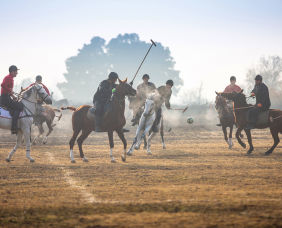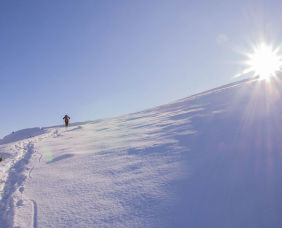interesting facts about Azerbaijan
Azerbaijan is a land of many mysteries, but also of plenty of facts. See 10 interesting facts about Azerbaijan here!
Azerbaijan is a land of many mysteries, but also of plenty of facts. See 10 interesting facts about Azerbaijan here!
Azerbaijan is often called the Land of Fire and there are several reasons why. The word ‘Azerbaijan’ literally means ‘protector of fire’; the country is abundant in oil and natural gas; it was a centre of fire worshipping; and fire has always been one of the symbols of our capital, Baku, which today is reflected in the amazing Flame Towers.
Once situated along the Great Silk Road, many peoples have passed through these lands, helping to shape the nation’s unique traditions of tolerance and hospitality. Today, Azerbaijan is a secular country where Sunni and Shia Muslims, Christians, Jews and many other small nations have been living in peace for centuries.
1918-1920 was fascinating time in Azerbaijan, with the first republic (the Azerbaijan Democratic Republic) introducing a number of innovations. One of them was the decision to grant women suffrage in 1918, making Azerbaijan the first country to do so in the Muslim East, and even beating many Western countries to it.
Azerbaijan is home to an amazing collection of about 350 mud volcanoes, many of which are found in a relatively small area around Baku and nearby areas of the Caspian Sea. It’s not surprising then that Azerbaijan is sometimes called ‘the mud volcano capital of the world’ – the ground here can indeed be messy, bubbling and explosive!
The world’s first private Museum of Miniature Books is located in Baku’s Old City, a historical and architectural reserve and a World Heritage Site. This extraordinary museum is also home to the world’s largest collection of miniature books, according to the Guinness Book of Records. On display here are over 5,500 of them.
Azerbaijan has a truly historic oil industry. In 1901 Baku’s oilfields were supplying over half the world’s oil, and during the Second World War accounted for approximately 75 per cent of oil produced in the Soviet Union. Baku oil therefore supplied the eastern front with the vast majority of the fuel that powered Soviet tanks and aircraft to victory.
Azerbaijan has some 713 km of coastline along the Caspian Sea, the world’s largest inland body of water and a remnant of the vast Parathethys Sea that stretched from the Alps to the Aral Sea. The capital, Baku, is the largest city on the Caspian and boasts beaches, boulevards and bars replete with calming sea views and breezes.
The Heydar Aliyev Centre, an architectural masterpiece designed by the late Zaha Hadid won the London Design Museum’s Design of the Year award in 2014. Its visionary, undulating form has become a symbol of modern Baku. Not a single straight line was used in its design. Inside you’ll also find world-class museums and exhibitions.
The beautiful Karabakh horse, native to Azerbaijan and a symbol of the country, is prized for its speed, stamina and beautiful chestnut colour. Traditionally bred in the Karabakh region, numbers have declined but breeding continues in western parts of the country. In 1956 a Karabakh horse was even gifted to British Queen Elizabeth II.
Azerbaijan is an ancient centre of carpet weaving home to seven regional schools, each distinguished by their own unique combination of patterns, colours and motifs. What’s more Baku boasts the state-of-the-art Carpet Museum, which is shaped like a rolled up rug and houses the world’s largest collection of Azerbaijani carpets.
Perched high in the foothills of the Greater Caucasus, the village of Khinalig is Azerbaijan’s top ethno-tourism spot and one of the highest settlements in Europe. This timeless mountain village was included on the Tentative List of UNESCO's World Heritage Committee in 2020. Its rare character can be seen clearly in the houses’ style of construction and their proximity to one another, which provides protection from the cold during frosts and blizzards. The people of Khinalig, considered one of the ancient Caucasian Albanian tribes, speak their own language that local residents call ‘Ketsh’.
Did you know that the world's first oil tanker went into operation in Baku in 1879? That year, the vessel named Zoroaster, ordered by the Nobel brothers for transporting crude oil extracted from the oil mines in Baku, was considered the world's first commissioned oil tanker.
Did you know that the natural thermal springs at Ilisu, formed due to water erosion, naturally created baths inside the mountain? These thermal springs, located 5 km north-east of Ilisu village, are nestled among the mountains. Of the two springs that flow from the same rocks, one is cold and the other is hot, popularly known as ‘Boy Spring’ and ‘Girl Spring.’ These natural thermal springs are typically sought out for the treatment of various skin diseases and rheumatic conditions.
There are beaches both to the north and south of Lankaran. The beaches' black volcanic sands are known for their therapeutic qualities and the water here is the clearest of all the Caspian Sea shores. Specifically, the black volcanic sands of this region are considered to have beneficial therapeutic effects on rheumatism, joint pains and spinal problems.
The French adventurer and writer Alexander Dumas was a guest in Shaki during his historic travels to the Caucasus. In his 1856 work ‘Journey to the Caucasus,’ about his impressions of the Caucasus, he discussed the beautiful natural landscapes of Shaki, its unique tangible and intangible cultural heritage, especially its local values, and shared some interesting facts.
The Old City (Icherisheher), considered the historical centre of Baku, is famous for its medieval stone buildings, traditional hammams, markets and tall defensive walls. Famous landmarks, such as the Maiden Tower and the Shirvanshahs’ Palace Complex, are also located here. The Old City, surrounded by walls built in the 12th century, is part of a UNESCO World Heritage Site.
Khudafarin Bridge, constructed over the River Araz in 1027, held great strategic importance as a means of communication in ancient and medieval times. What distinguishes this bridge from others in the country is its valiant survival through centuries of tribulations. Also known as the ‘Bridge of Longing’, Khudafarin Bridge has witnessed wars throughout history, once again becoming a symbol of unity after being liberated from occupation in 2020.
Do you know the a fascinating link between the ironwood tree, found in the Talish forests, and the Nobel Foundation? Alfred Nobel, who established the foundation, was also involved in manufacturing rifles. When he learned about this particular tree, known for its suitability in making durable rifle stocks, he came to Azerbaijan. It was here that the renowned Swedish inventor encountered the oil wells of Baku, erupting like fountains, which prompted him to begin an oil field venture. Therefore, the ironwood tree, survior of the last Ice Age and indigenous to the southern region of Azerbaijan, marked a pivotal moment in the life of the Nobel millionaire.
The unique Museum of Longevity can only be visited in Azerbaijan, located in Lerik, the land of longevity. Operating since 1991, the museum displays over 2,000 exhibits, including photographs and personal items of residents who have lived for over 100 years. Foreign guests visit the museum in hope of learning the secrets of longevity.

